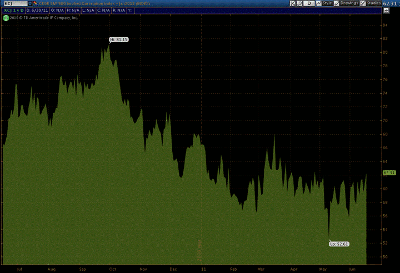A well-known fund has just made a huge bet using a particular option strategy that seeks to profit from “dispersion,” or a condition where stocks in various industries stop rising and falling in unison.
Och-Ziff Capital Management (OZM), the publicly traded fund of funds, is getting some attention today from its 13F disclosure to the SEC in May. The asset manager disclosed that it bought nearly $12 billion in equity options in the first quarter of 2011. Some traders interpreted this as a straightforward bet on increasing volatility, but I had the following comments in a May 16 Bloomberg story:
“Och-Ziff might be following an options strategy known as a “dispersion trade” that has become increasingly popular this year, said Jared Woodard, principal at Condor Options, a New York-based trading and research firm that focuses on market-neutral strategies.
Dispersion trades are a way of betting on an end to the historically high market correlation that began during 2008, when shares of companies in various industries all rose and fell together, frustrating money managers who earned their keep by researching and picking individual companies.
In a dispersion trade, managers sell put and call options on an index such as the S&P 100 during market declines, when demand is heavy among investors who want to protect themselves from losses. They use the rich premiums received for the index options to buy put and call options on some or all of the stocks comprising the index.”
The option purchases were pretty evenly split, with $4.65 billion in calls and puts worth $7.14 billion purchased. The missing piece that would really cement this “dispersion trade” thesis is if we knew that OZM had also sold some index options in size. They haven’t disclosed any such position in the index.
Even so, I would be surprised if this wasn’t some sort of bet on dispersion. Och-Ziff reportedly bought options on 93 of the stocks in the S&P 100, and that doesn’t sound like tactical stock picking to me.
Implied correlation has remained high since 2008, with readings in the 60-65 range for the CBOE’s implied correlation indexes (pictured below) constituting the “new normal.” A return to the previous era would see those indexes back in the 30-40 range.
I’m not actually a fan of betting against high correlation here, even several years after the financial crisis. Intuitively, an environment in which individual index components move more independently is an environment in which the details of those individual companies are the primary drivers of stock prices, and broad macroeconomic factors are less important. As far as I can tell, we’re still living in a risk-on/risk-off world.
You know how, when guests and anchors on financial television networks run out of things to say, they sometimes resort to, “Well, it’s a stock picker’s market?” Besides being perennially vapid, as far as I can tell, that claim is still mostly false.
By Jared Woodard, principal, Condor Options



















